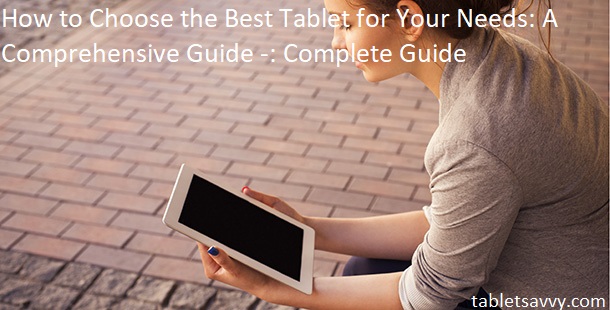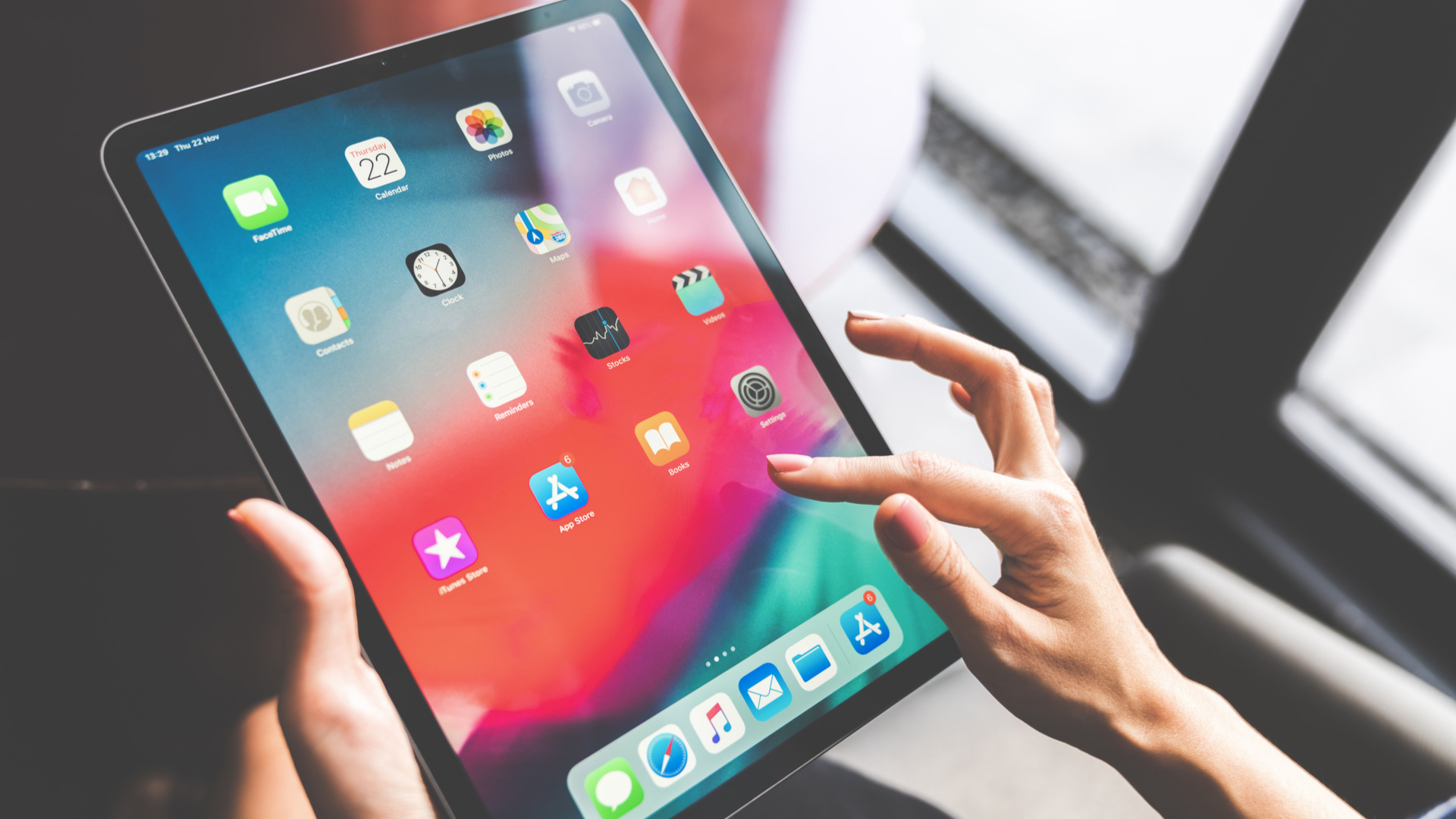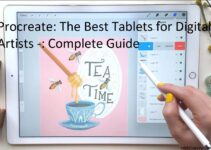Looking for the perfect tablet for your needs but don’t know where to start? You’re not alone! With a dizzying array of tablets on the market, choosing the best one for you can feel overwhelming. But fear not!
This comprehensive guide will de-mystify the process, helping you pick the ideal tablet for your lifestyle and budget.
Choosing the right tablet can be a daunting task. With so many models on the market, it’s hard to know which one is best for your individual needs.
In this complete guide, we’ll walk you through everything you need to consider before buying a tablet so that you can make an informed decision. We’ll look at the different types of tablets available and provide tips on how to narrow down your choice, as well as what features are important to keep in mind when comparing models.
Additionally, we’ll share some tips and tricks for getting the most out of your tablet and advice on which accessories can enhance your experience.
Whether you’re looking for a device for work or play, this guide will help you make the best decision!

Definition of a tablet
A tablet, also known as a slate computer or tablet PC, is a touch-screen mobile computing device with an on-screen virtual keyboard, typically larger than that found on a smartphone. It usually utilizes an operating system (OS) designed specifically for tablets. Tablets typically provide more functions and features than smartphones due to their larger screen size and higher processing power.
Some tablets come with Bluetooth enabled keyboards or mouse attachments, while others do not have this functionality.
In addition to running applications made specifically for tablets, most modern tablets are capable of connecting to high-speed internet over Wi-Fi or other wireless networks. Tablet users can stream audio and video, send emails and text messages, play interactive games, access the internet via web browsers and more. Depending on the device’s operating system and available apps, some models run the same software found on personal computers such as Microsoft Office suite products or Adobe Photoshop. This can help to bridge the gap between traditional laptop computers used primarily for working and editing documents compared with slates that are optimized for consuming media such as videos, music and books.
Importance of choosing the right tablet
Choosing the right tablet is vital, no matter what your reasons for wanting one. Before making a purchase, it’s important to consider which features are necessary and how they fit into your budget. Even if you’re just interested in watching videos and checking Facebook, there are plenty of choices available.
The size of the screen will impact how easy it is to use, as well as how likely you are to have issues with eye strain. Consider both the length and width of a tablet for comfortable viewing. You should also assess the storage capacity to determine if it will suffice for all your needs.
Power is an additional factor that should be taken into account when deciding between tablets. If you plan on using this device intensively, then opting for a stronger processor will ensure smooth operations and reduce lagging when transferring data or running multiple programs at once. The operating system can play a large role in its overall usability, so think carefully about which type works best for you before purchasing any device. Finally, look at internet connectivity — this may not be necessary now, but could be crucial down the line if you want to stay connected on-the-go or set up streaming services such as Netflix or YouTube Music Premium.
Overview of the guide
This complete guide offers a detailed overview of tablets and the different ways in which they can be used. From choosing the right size and features to understanding how a tablet can benefit you, this guide is designed to help you make an informed decision when it comes to selecting the best tablet for your needs.
Areas covered include:
-What is a Tablet?
-Features of different tablets
-Different aspects to consider in your research
-Tips on getting the most out of your tablet
-How to use your new device
Tablets provide unique advantages, so understanding their capabilities is key. Learn more about their features, specs and costs so you can make an informed decision on which tablet model best fits your lifestyle.
Determine Your Needs

Before you start researching tablets, make sure to assess your needs—everything from internet surfing and watching movies to gaming and photo editing. Ask yourself the following questions:
-What do I need this tablet for?
-Do I require a fast processor? Will it be used for intensive tasks like video and photo editing?
-Do I need a great battery life or will it be used as a home device with a plug nearby?
-How much storage do I need? If I require extra, can it be added easily with an external drive or memory card?
-Do I need the latest operating system or can I get by with an earlier version?
-Do the ports matter to me – HDMI, USB, etc.? Do I require ports that allow me to connect other items such as game controllers, keyboards, etc.?
-Can my budget handle everything that’s included in the package (stands/cases/chargers)?
Article continued…
Considerations for usage
When shopping for a tablet, there are many factors to consider. Each person has different needs when it comes to technology and it is essential to choose a device with the features that will suit your desired use. Before purchasing a tablet, consider the following criteria.
Operating System: Tablets typically operate under either iOS or Android operating systems, with some offering Windows compatibility as well. Different operating systems offer different features and benefits, so research your options before deciding which system is best for you.
Processor: Tablets come with processors ranging from basic to ultra-powerful. The processor type and speed play an important role in the overall performance of the tablet – the faster the processor, the faster your applications and downloads will be.
Memory: Memory is another important factor when choosing a tablet as it determines how much data you can store on your device at one time. Consider what types of files you plan to save on your device – photos, music and other media require more memory than plain text do – in order to determine which capacity will serve you best.
Connectivity: Many tablets come with built-in Wi-Fi capabilities that allow users to connect their devices to wireless networks or hotspots while they’re out and about or at home— some devices even offer cellular connectivity as an additional feature for convenient use on-the-go internet access.
Battery Life: Battery life is one of the most critical components of any tablet—choose something that offers sufficient power for several hours of use without need for frequent recharging in order to ensure smooth performance when needed most.
Operating System (OS)
The operating system (OS) of a tablet is the software that runs on the device, dictating its basic behaviours and features. Common operating systems for tablets are Android, iOS (for iPad tablets), Windows, Chrome OS and Blackberry OS. Each OS offers different advantages in terms of usability, features, flexibility and security.
Android is a highly customisable OS that supports a wide range of applications and hardware. Most Android tablet devices are designed using Google’s mobile operating system. This allows users to more freely transition between different devices and access content from Google Play Store. It is also highly compatible with third-party apps and cloud services such as Dropbox or Evernote.
iOS (also known as iPadOS) is the dedicated mobile operating system developed for Apple’s iPad range of tablets. It offers easy to use controls via the home button and touch screen combinations which makes navigating iPads much simpler compared to Android counterparts. iOS also offers exclusive access to App Store for downloading third-party apps such as games or productivity apps specifically optimised for iPads elements such as the pen or split-screen mode capabilities, displaying maps etc..
Windows is Microsoft’s desktop/laptop operating system that has been repurposed and designed specifically for tablet modes of use with touchscreen input available across models such as Surface Pro tablets etc.. Windows OS provides users with flexibility in terms of functionality while still delivering full support for PC/desktop apps like Microsoft Office suites or audio/video editing software thanks to Intel Core processing units these tablets come equipped with – making them optimal choices for business purposes especially when it comes to heavy tasks & performance intensive jobs requiring extra power & optimised efficiency levels provided by larger RAM memory & computing capabilities that Windows tablets offer enabling users to do more in shorter time frames via multitasking capabilities made possible due to faster response rates optimized across entire available range of apps combined into single computing interfaces powered by discrete technologies & robust handling performance capacities ideal regardless if focusing on user workload or enjoying some entertainment while travelling without having to carry heavier laptops or separate gadgets making them perfect choice when it comes to balancing work & pleasure all at same time thanks plenty opportunities offered by this OS itself while riding along parallel implementations merging both aforementioned activities with ease no matter if aiming at professional breakthroughs or just some rest&relaxation sessions through favourite entertainment platforms available all within few taps away on screen no matter where you choose completely liberating digital experience available around instantaneously waiting there just nearby tip of your each finger ready anytime whenever you need simply magical feeling not worth missing out!
Screen size and resolution

The screen size and resolution of a tablet will have a major impact on how comfortable the device is to use and the kind of applications you can run. Tablets come in wide range of sizes, from mini 7-inch formats to bigger 12-inch sizes. The biggest tablets may not be portable enough for some users, but they can make up for it with higher resolutions.
Consider a model with a higher resolution if you plan to do graphics or video editing since higher resolutions will let you see finer details within images and videos. Also consider factors such as aspect ratios, viewing angles and battery life when selecting a tablet with an appropriate screen size and resolution.
A wide viewing angle is especially important if multiple people are going to be viewing the content on the device at once. Battery life is often sacrificed in favor of better display specs so ensure you know what tradeoffs there will be from different specs when making your choice.
Battery life
When choosing the right tablet for your needs, a key factor to consider is battery life. Knowing how long a tablet can run on a single charge can make all the difference when you’re trying to get work done or entertain yourself on the go.
The average consumer-use laptop or tablet can range from 8–12 hours on average. Most devices listed as “Ultra Slim” have smaller batteries that may not exceed 8 hours of use time per charge, but some high performance devices equipped with large batteries may provide up to 15+ hours of battery life. Make sure you take into account how much time you spend away from an outlet and your power needs when looking for your device.
It’s also worth noting that certain activities may have more significant effect on battery life than others. Watching movies and playing games, though enjoyable, will inevitably shorten battery life more than browsing the web or writing documents when it comes to tablets—your sleeping bag won’t provide quite the same comfort! Knowing what activities are most important to you will help ensure you buy a device that meets your needs while giving you enough freedom away from power sources throughout your day-to-day routines.
Connectivity options
When shopping for a tablet, connectivity is a major factor to consider. Depending on where you’ll be using the device most often, you’ll want one with the best technology and strongest connection options. Most tablets come with built-in Wi-Fi technology, giving you access to streaming services, cloud storage apps and other web-based apps.
Many advanced models can also connect to cellular networks to enable mobile data use while you’re away from a reliable Wi-Fi connection. For example, if you plan to use your tablet while commuting or traveling, it may be worth opting for a model with cellular capabilities. Different carriers offer varying data speeds and coverage areas so make sure to do your research before committing.
Other advanced tablets are equipped with Bluetooth technology allowing them to connect with accessories like mice and keyboards for added convenience. Some even come with near field communication (NFC) which allows for simple data transfers that require no complex pairing process between two different devices as is sometimes required by Bluetooth connections.
Performance
When shopping for a tablet, performance should be one of your top considerations. If you plan to use your device for things like web browsing, casual gaming, and multimedia streaming, the processor is especially important. Most tablets come with either an ARM processor or an Intel-based Core i-series processor.
ARM (Advanced RISC Machine) processors are designed to provide superior battery life and are used in most budget devices. They tend to be fairly slow when it comes to multitasking and may not run certain apps as smoothly as Intel-based processors.
Intel®-based Core™ i3, i5, or i7 processors provide much more power and speed than ARM ones and offer excellent performance for more demanding tasks like photo editing or playing 3D games. However, devices equipped with a Core™ processor usually cost significantly more than those with an ARM processor and tend to have shorter battery life.
Processor

The processor (CPU) is the powerhouse of a tablet. It determines how quickly your tablet can run applications, games, web browsers, and multitask. The most popular type of processors right now are made by Intel and ARM, though you may see others on the market.
Intel-made processors dominate in terms of performance, multitasking capabilities, and power. However, they require more power to run and may not offer the best battery life. ARM-based processors are becoming increasingly popular thanks to their energy efficiency which translates into good battery life but lower performance compared to Intel chips.
To choose the best processor for you depends on what you plan to do with your tablet — if all you plan on doing is basic web browsing and media streaming then an Intel Atom-based processor would be great; if you want something for gaming or serious multimedia tasks with no lag then an Intel Core M3 or better would be ideal; if you want portability and long battery life then a low powered ARM-based processor is the way to go.
Conclusion
When selecting the right tablet for your needs, there are a number of factors to consider. First, determine what features you need in a tablet. Would you like one with a large display or extended battery life? Will you need multiple ports and storage options? Consider what type of connectivity is available, such as Wi-Fi or cellular data. Finally, think about the size and weight. Compare different models within your budget to help narrow down your choices and make an informed decision.
No matter which model you choose, a tablet offers an enjoyable experience for work, play and more. With the right model for your needs, making productivity more efficient can be accomplished at the touch of a finger. When choosing the best tablet for your needs, use this comprehensive guide to make an informed decision that best suits your lifestyle.—consuming complex tasks can be made quickly less bothersome with the correct device suited for yourself.
FAQ’s
What are the specifications of a good tablet?
A good tablet should have a high-quality display, fast processor, ample storage space, good battery life, lightweight design, and a decent camera.
Which tab is best for everything?
There is no single tablet that is best for everything as it depends on your specific needs and preferences. However, some popular options include the iPad Pro, Samsung Galaxy Tab S7, and Microsoft Surface Pro.
What you need to know before buying a tablet?
Before buying a tablet, you should consider factors such as the operating system, screen size, processing power, storage capacity, battery life, and connectivity options. You should also determine your budget and intended use for the device.
What to look for when buying a used tablet?
When buying a used tablet, you should examine the device for any physical damage, test the battery life and performance, check for any software issues or malware, and ensure that the device is not reported stolen or lost.
How many GB should a good tablet have?
A good tablet should have at least 64GB of storage, although 128GB or higher is ideal if you plan to store a lot of apps, files, or media.
Which tablet is best in value?
Some of the best value tablets include the Amazon Fire HD 10, iPad (8th generation), Samsung Galaxy Tab A7, and Lenovo Tab M10 Plus.
Which brand tablet is best?
The best brand for tablets depends on personal preference and needs. Some of the popular brands include Apple, Samsung, Microsoft, Amazon, and Lenovo.
What are the 5 kinds of tablet?
The five types of tablets are convertible, slate, rugged, gaming, and kid-friendly.
How much should I spend on a tablet?
The amount you should spend on a tablet depends on your budget and intended use. You can find basic models for under $100, while high-end tablets can cost $1,000 or more.
How much RAM do I need in a tablet?
The amount of RAM you need in a tablet depends on the intended use. For basic tasks like browsing the web and streaming videos, 2-4GB of RAM is sufficient. For more demanding tasks like gaming or graphic design, 6GB or higher is recommended.
See Also:
- Best tablet for reading comics 2023
- Best tablet for reading pdf 2023
- Best tablet for streaming movies 2023
- Best battery life tablet 2023
- Best tablet for video calling 2023


